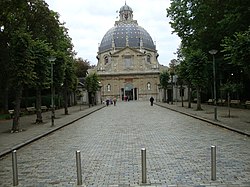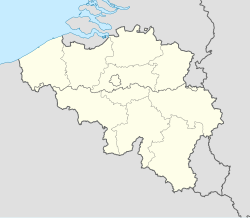Scherpenheuvel-Zichem
This article needs additional citations for verification. (November 2020) |
Scherpenheuvel-Zichem | |
|---|---|
City and municipality | |
 Scherpenheuvel basilica | |
| Government | |
| • Mayor | Manu Claes (CD&V) |
| • Governing party/ies | CD&V-Open VLD |
| Area | |
• Total | 51.15 km2 (19.75 sq mi) |
| Population (2018-01-01)[1] | |
• Total | 22,952 |
| • Density | 450/km2 (1,200/sq mi) |
| Postal codes | 3270-3272 |
| NIS code | 24134 |
| Area codes | 013, 016 |
| Website | www.scherpenheuvel-zichem.be |
Scherpenheuvel-Zichem (Dutch pronunciation:
Holy site
Scherpenheuvel (English: "Sharp Hill"), the most important pilgrimage (
Legend has it that around AD 1500 the
In January 1603 another miracle was reported: the statue wept tears of blood. The religious schism in the Netherlands was blamed for the pain Mary felt. In November 1603 the Spanish army defeated Protestant troops besieging 's-Hertogenbosch, an important fortification in Northern Brabant.

In 1604, a few months after its inauguration by the
Also in 1604, Philips Numann, clerk of the archbishop of Mechelen, described the legend of Scherpenheuvel in his Historie der Mirakelen (History of Miracles). The legend was classified as a "folk-tale", but he also reported the miracles that were recognised as such by the Catholic authorities. His book was translated from Dutch into French, Spanish and English and spread the fame of Scherpenheuvel all over Western Europe.
In 1607, the famous architect-engineer Wenceslas Cobergher was commissioned to build a bastion of Catholic Counter-reformation: the whole city was to be an allegorical homage to the Mother of God, a hortus conclusus symbolizing her eternal virginity. Seven lanes lead towards the church. Its layout is based on a 7-pointed star, which stands for the abundance of God's mercy. In the church, the advent of Jesus is announced by six Old Testament prophets and realised by Mary who gives birth to the Messiah. In 1609 the first stone was put in place for the unique structure in highly developed baroque style, which was finally inaugurated in 1627. The streets and layout of the town itself were designed to mirror the shape. With its surroundings, it is now one of the best examples of the triumphalist architecture of Counter-Reformation in Belgium. The dome, adorned with 298 golden stars, symbolizes the cosmos. The main altar is said to be placed on the exact spot where the old oak tree once stood. Archduchess Isabella attended the inauguration-mass without her deceased husband. She came on foot from nearby Diest, which gave rise to the foot-pilgrimages that still survive from places as distant as Maastricht and Bergen op Zoom. She put all her gold and jewellery before the altar, a custom that persists to this day, in the form of coin throwing.
The pilgrimage at Scherpenheuvel flourished. The Oratorianen, an order of religious fathers occupied with religious worship and pilgrimage logistics, had their abbey connected to the church by the "baroque gallery". They were chased away during the French occupation after the 1797 revolution and did not return until after the religious restoration at the beginning of the 19th century.
In 1927, the church was proclaimed a Roman Catholic "basilica minor".
Other traditions that survive the centuries at Scherpenheuvel are the Kaarskensprocessie (Procession of the candles) on 2 November and blessing-processions for people, pets and animals, and vehicles. The popularity of the pilgrimage also has a lot to do with the year-round fairground atmosphere that characterizes the place: Many stalls selling souvenirs, sweets, typical baked goods such as "pepernoten" and "noppen", hotels, bars and restaurants of different kinds.
References
- ^ "Wettelijke Bevolking per gemeente op 1 januari 2018". Statbel. Retrieved 9 March 2019.
- ^ https://inventaris.onroerenderfgoed.be/erfgoedobjecten/140043 - alternatieve namen -
- ^ "Demographic statisticsMunicipality of SCHERPENHEUVEL-ZICHEM, population density, population, average age, families, foreigners".
External links
- Geschiedenis - Scherpenheuvel en Kevelaer (in Dutch)





